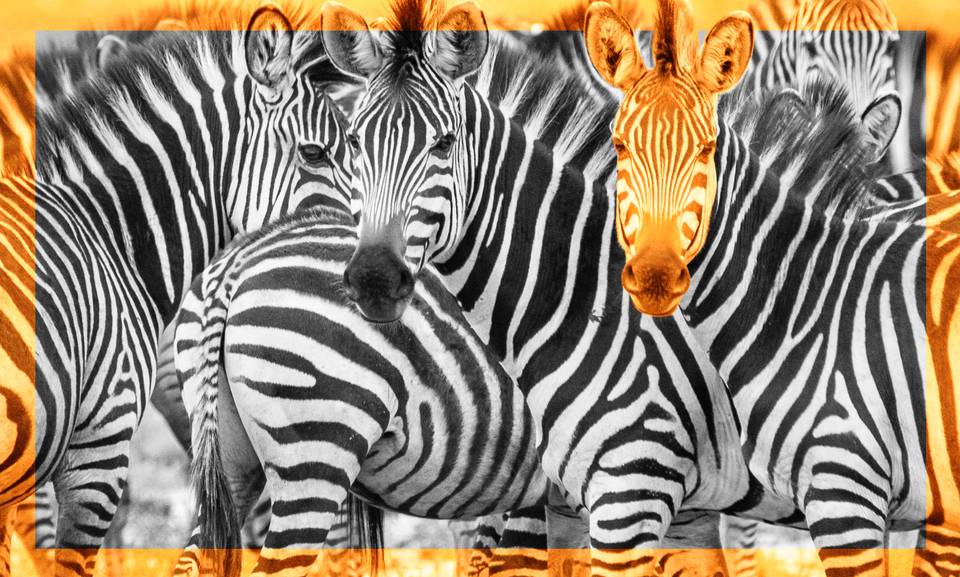Zebras are very different from other animals. You can tell the difference in an instant. Their high-contrast, striped pattern makes the distinction very obvious. That is — when you compare zebras to other animals, even horses. Zebras do look very much alike, though, when you compare one zebra to another.
Having seen a zebra once, you’d remember it forever. You’d put it in a separate category from all the other horses. As a newbie zoologist, you might even regard a Zebra as a stand-alone, having-nothing-to-do-with-horses kind of species. And that’s OK for a newbie.
When consumers encounter something for the first time and when an entity is distinct enough, they would put it into its own category even when a perfectly reliable category (of horses) already exists. Most customers are newbies to new categories.
But when the category (of zebras) is already present in consumers’ minds it becomes quite challenging for clients to make a distinction between one zebra and another — between a company and its direct competitor.
Differentiation is key for a company to be regarded as a different kind of business entity in its category by a prospect. A whistling, yellow & purple striped zebra would definitely stand out from the rest of the herd. So why aren’t there a bunch of really different zebras; why would companies choose to stay like every other company in its category?
Zebras have stripes and people might say that it is a great camouflage. But if you think about it — it’s not. Lions are camouflaged — like grass: beige and yellow. Zebras are black and white and you can distinguish a zebra from miles away. So their camouflage as means of survival isn’t a good theory.
Zebras, however, have a strategy that allows them to stay safe. Their patterned, highly contrast, striped skin is the key. It might seem that a zebra is such an easy prey to predators — it’s easy to notice one since it cannot hide itself against the environment. But zebras aren’t doing that. Zebras are herd animals. They hide against their herd. Therefore, it’s quite challenging for predators (and humans too) to parse out a single zebra. When it’s hard to pick one zebra out the chances of survival are higher for all the zebras in the herd.
A while back a bunch of scientists have decided to observe some zebras. When they tried to take notes on a particular zebra they failed because of the camouflage. So someone came up with a bright idea to mark zebras by applying some paint on their hips, making each subject identifiable. What happened next? Those marked zebras got eaten. Whenever a single zebra becomes different: a foal, limping, old, clipped or otherwise marked — it’s as good as dead. Lions can easily organise their hunt around a single zebra, not the whole herd.
Zebras prefer to stick together, stay in the middle and not to stand out. Those who dare to stray from the group are bait. Companies seem to have adopted the Zebra strategy — keep your stripes on so that the lions won’t eat you. But who are the lions; who are the companies so afraid of? What makes them resist the differentiation?
What if there is nothing to be afraid of? What if the lions are the prospects who need to be able to pick the company out from the herd of look-alike zebras? Clients don’t want to do you in — they desire what you can do for them. Every client (secretly) wants to have a (slightly) different zebra.
Most companies aren’t aiming at success (despite their claims); they are aiming at survival. There is a real danger in being visible: you might be either highly successful or you might end up being highly dead. Companies are on a constant lookout for predators who might gnaw on them. So they choose to stay in the middle, to avoid threat, not draw unnecessary attention, don’t get picked.
Every company basically is a team of people. And the primary motivation of each person on the team is to be invisible and left alone. In business, however, to be really successful the company has to voluntarily adopt the reverse motivation: being highly visible and outgoing. Luckily, there aren’t many who’d dare to do that which leaves the window of opportunity open for your business. The question stands — will you take a chance or will you continue hiding against the herd?
The awezzom question of the day:
How can we stand out from the competition so that it would be easier for our prospect clients to make a decision?

